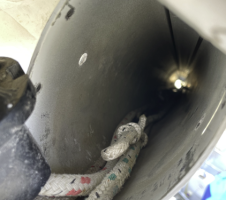Phr3d
Member III
Well, the source of the main halyard drag was a wire/nylon slug that had worn and the wire pulled out of the nylon. Of course, matching that one was a needle-in-a-haystack. In my search, I found a slightly larger slug that would fit in the mast. Changed all of them. Sail goes up and down like butter. Now.
The main still has quite a bit of weather helm in a puff. Dropping the traveler, vanging, outhauling, extra halyard tension didn't seem to make a difference. I plan to rig a cunningham, but I'm wondering could the rig be leaning backward? Would that affect the headsail shape? How does one measure such a thing? Or is the main just at the stretched out age of replacement?
Also, do I really want a 135 genoa? It is really baggy and seems to overpower the boat. I put the cars pretty far back and spilled air in the resulting twist. The boat has a gennaker in a sock. I'm thinking maybe to pull out the genoa and get a jib and use the gennaker for lighter air. Is all of this related to the main sail weather helm issue?
The main still has quite a bit of weather helm in a puff. Dropping the traveler, vanging, outhauling, extra halyard tension didn't seem to make a difference. I plan to rig a cunningham, but I'm wondering could the rig be leaning backward? Would that affect the headsail shape? How does one measure such a thing? Or is the main just at the stretched out age of replacement?
Also, do I really want a 135 genoa? It is really baggy and seems to overpower the boat. I put the cars pretty far back and spilled air in the resulting twist. The boat has a gennaker in a sock. I'm thinking maybe to pull out the genoa and get a jib and use the gennaker for lighter air. Is all of this related to the main sail weather helm issue?
Last edited:







